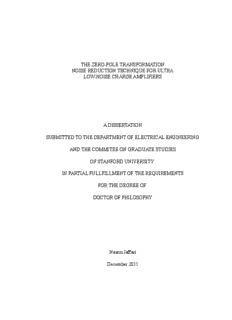Table Of ContentTHE ZERO-POLE TRANSFORMATION
NOISE REDUCTION TECHNIQUE FOR ULTRA
LOW-NOISE CHARGE AMPLIFIERS
A DISSERTATION
SUBMITTED TO THE DEPARTMENT OF ELECTRICAL ENGINEERING
AND THE COMMITEE ON GRADUATE STUDIES
OF STANFORD UNIVERSITY
IN PARTIAL FULLFILLMENT OF THE REQUIREMENTS
FOR THE DEGREE OF
DOCTOR OF PHILOSOPHY
Nasrin Jaffari
December 2011
© 2011 by Nasrin Jaffari. All Rights Reserved.
Re-distributed by Stanford University under license with the author.
This dissertation is online at: http://purl.stanford.edu/hp310vp3671
ii
I certify that I have read this dissertation and that, in my opinion, it is fully adequate
in scope and quality as a dissertation for the degree of Doctor of Philosophy.
Bruce Wooley, Primary Adviser
I certify that I have read this dissertation and that, in my opinion, it is fully adequate
in scope and quality as a dissertation for the degree of Doctor of Philosophy.
Boris Murmann, Co-Adviser
I certify that I have read this dissertation and that, in my opinion, it is fully adequate
in scope and quality as a dissertation for the degree of Doctor of Philosophy.
Katelijn Vleugels
Approved for the Stanford University Committee on Graduate Studies.
Patricia J. Gumport, Vice Provost Graduate Education
This signature page was generated electronically upon submission of this dissertation in
electronic format. An original signed hard copy of the signature page is on file in
University Archives.
iii
iv
Abstract
This research focuses on the design of ultra low-noise charge amplifiers for use in
sensor and photo-detector systems. Charge amplifiers are used in the front-end design
of systems that have an input signal in the form of charge or a current pulse.
Applications for such systems include photography, radar imaging, medical imaging,
X-ray fluorescence applications and particle-physics experiments.
A charge amplifier is used to convert the incoming charge or current to a
voltage for further processing. The noise level of a charge amplifier determines the
minimum signal that can be measured by the system, as well as its resolution. There
are many applications that would benefit from imaging systems with lower noise
levels than those available today.
The objective of this research is to define the optimal flow for the design of a
low-noise charge amplifier. The work introduces a zero-pole transformation
technique that lowers the noise level of charge amplifiers without introducing much
complexity or requiring substantial extra area. This method may be implemented in
any sensor or imaging system that has an input in the form of a packet of charge or a
current pulse.
A zero-pole transformation charge amplifier has been designed in 0.18µm
CMOS technology and fabricated by National Semiconductor. The theory of the zero-
pole transformation technique is validated by the experimental design, the measured
v
results agreeing well with the expected noise reduction based on the theories
developed for the proposed method. The experimental zero-pole transformation
charge amplifier shows a reduction in 40% in its input-referred noise compared to a
basic charge amplifier. The minimum input-referred noise level achieved in the
proposed charge amplifier is 102ENC (equivalent noise charge).
vi
Acknowledgments
First and foremost I would like to thank my principal adviser, Professor Bruce A.
Wooley, for giving me the opportunity to perform research under his guidance and
take advantage of the many resources available at Stanford University. Professor
Wooley has granted me enormous freedom in forming my research objective which I
believe is an invaluable aspect of his advising style. I also appreciate his assistance in
improving the clarity and precision of my communication skills.
I would also like to extend special thanks to Dr. Katelijn Vleugels for her
support in forming and developing my research ideas. Katelijn has provided me with
extensive technical guidance which has made the conduct of this research possible.
I gratefully acknowledge the members of my orals committee: Professor
Murmann and Professor Gill I would like to thank the Molecular Biology Consortium
for providing financial support during much of my stay at Stanford University.
Additionally, I would like to express special gratitude to National Semiconductor for
the fabrication of the circuits I have developed as part of my research. The assistance
of the other student members of Professor Wooley's research group has been
invaluable in the design and testing of my prototype chip.
Finally, I would like to thank my husband for his support of my studies, which
has made the conclusion of this research possible. I would also like to acknowledge
my parents which have always encouraged me to pursue my studies.
vii
viii
Table of Contents
Abstract...........................................................................................................................v
Acknowledgments........................................................................................................vii
List of Figures..............................................................................................................xiv
Chapter 1 Introduction 1
1.1 Motivation.........................................................................................................1
1.2 Organization...................................................................................…...............5
Chapter 2 Noise in Electronic Circuits 7
2.1 Fundamental Noise Sources..............................................................................7
2.1.1 Thermal Noise........................................................................................8
2.1.2 Flicker Noise..........................................................................................9
2.1.3 Shot Noise............................................................................................10
2.2 Noise in MOSFET Devices.............................................................................10
2.2.1 Thermal Noise in MOSFET Devices...................................................10
2.2.2 Flicker Noise in MOSFET Devices.....................................................12
2.2.3 Shot Noise in MOSFET Devices.........................................................13
2.3 Effect of Feedback on Noise...........................................................................14
2.4 Summary.........................................................................................................15
Chapter 3 The Charge Amplifier 17
3.1 Principle of Operation.....................................................................................17
ix
3.2 Reset Mechanisms...........................................................................................20
3.2.1 Pulsed Reset.........................................................................................20
3.2.2 Continuous Reset..................................................................................22
3.3 Performance Metrics.......................................................................................25
3.4 Noise...............................................................................................................28
3.5 Applications....................................................................................................30
3.5.1 X-ray Imaging......................................................................................31
3.5.1.1 Crystallography.......................................................................31
3.5.1.2 X-ray Fluorescence Analysis (XRF).....................................32
3.5.1.3 X-ray Astronomy...................................................................32
3.5.2 Particle Physics....................................................................................33
3.5.3 Optical Systems....................................................................................33
3.5.4 Medical Electronics..............................................................................35
3.5.5 Micro-Electro-Mechanical Systems (MEMS).....................................35
3.6 Summary.........................................................................................................36
Chapter 4 Low-Noise Charge Amplifier Design 39
4.1 Amplification Stages.......................................................................................40
4.2 Single-Stage Amplifier Topology....................................................................41
4.2.1 Common-Source Amplifier..................................................................42
4.2.2 Cascode Amplifier................................................................................42
4.2.3 Folded Cascode Amplifier....................................................................45
4.3 Input MOSFET................................................................................................45
4.4 Transistor Sizing.............................................................................................45
4.5 Correlated Double Sampling...........................................................................49
4.6 Pulse Shapers..................................................................................................50
4.7 Signal Averaging.............................................................................................51
4.8 Summary.........................................................................................................52
Chapter 5 Zero-Pole Transformation Noise Reduction 53
5.1 Boosting and De-boosting...............................................................................54
5.2 The Zero-Pole Transformation Theory of Operation......................................56
x
Description:This research focuses on the design of ultra low-noise charge amplifiers for use in sensor and circuitry before being digitized with an on-chip analog-to-digital converter (ADC). The noise level of the . to the DC current. Also, shot

